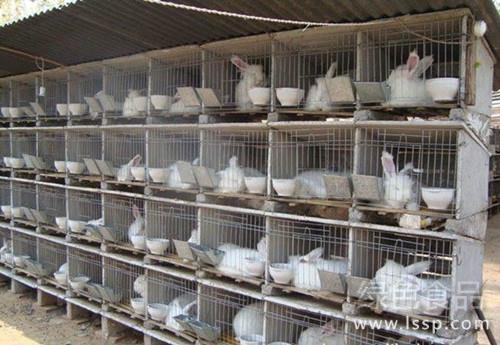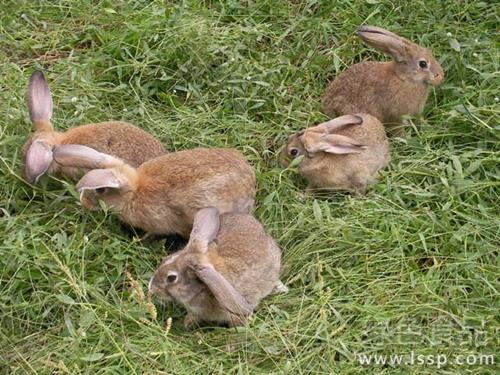Fattening can improve meat quality and increase yield seven elements of fattening rabbits
In order to improve the meat quality and increase the meat yield of rabbits, first of all, fattening should be carried out before slaughtering. Fattening is to increase the nutrient storage in rabbits in a short period of time. Now I would like to introduce to you 7 key points for increasing rabbit meat production.

Rabbit fattening
The main results are as follows: (1) the fattening of rabbits is mainly based on concentrate.
After the completion of skeletal growth and development, the weight gain in the fattening process of rabbits is mainly muscle and fat. When fattening, it should be based on concentrate, requiring feed crude protein 1618%, crude fiber 15%, digestible energy 2500 calories. Commonly used fattening feeds are barley, corn, wheat bran, bean cake, radish, potato, Fan Ru and so on. Should choose the feed that contains many sugars such as sweet potato, radish and so on. Properly combined with green feed.
(2) fattening rabbits should be divided into groups reasonably.
Fattening rabbits are mostly raised in groups, which should be raised in groups according to the shape and physique of rabbits in order to prevent fights and affect the fattening effect.
(3) fattening male rabbits should be castrated.
Castration should be performed on fattening male rabbits in order to increase meat yield and reduce feed cost. Because after castration, the metabolism and oxidation in the body are reduced, which is beneficial for rabbits to hoard fat. Under the same feeding conditions, the increased importance of castrated male rabbits was 10-15% higher than that of uncastrated male rabbits.
(4) create a quiet environment for fattening rabbits.
In order to improve the fattening effect and reduce feed consumption, the exercise of rabbits should be restricted during the fattening period, and should be kept in a warm, dark rabbit house and keep a quiet environment, which can promote the storage of meat and fat.
(5) feeding method.
There are two ways of restricted feeding and free feeding. During the fattening period, due to the reduction of exercise, the feed is mainly concentrated, showing poor appetite, so it is necessary to feed less and eat more, so as to increase food intake and provide adequate drinking water at the same time, so as to prevent the loss of appetite from affecting feed digestion, nutrition absorption and metabolism.
(6) provide adequate drinking water.
During the fattening period of rabbits, there is a gradual transition from green feed to concentrate fodder. at this time, in order to meet the water needs of rabbits, clean drinking water should be guaranteed for 2 to 3 times a day.
(7) careful management.
During the fattening period, because of high feeding density, lack of light, limited exercise, poor physical resistance and easy to get sick, rabbits should be checked frequently, pay attention to environmental hygiene, rabbit houses and cages should be cleaned and disinfected regularly. To ensure that the fattening rabbits can eat well, have a good rest, and have a good health condition.
- Prev

Diagnosis of Candida albicans infection in deer
As a conditional pathogen, Candida albicans (Candidaalbicans) can normally exist in human and animal oral mucosa, gastrointestinal tract, anus, vagina, skin and other parts, generally does not cause disease, but when the body is malnourished, vitamin deficiency, long-term use of antibiotics, the probability of Candida albicans infection increases, serious cases can lead to other organ infections and even death. The single infection of Candida albicans from animals is rare, and it is generally mixed infection, because it is not harmful.
- Next

Prevention and treatment of common diseases of rabbits in winter with colds, pneumonia, diarrhea, scabies and constipation
Prevention and treatment of common diseases of rabbits in winter with colds, pneumonia, diarrhea, scabies and constipation
Related
- On the eggshell is a badge full of pride. British Poultry Egg Market and Consumer observation
- British study: 72% of Britons are willing to buy native eggs raised by insects
- Guidelines for friendly egg production revised the increase of space in chicken sheds can not be forced to change feathers and lay eggs.
- Risk of delay in customs clearance Australia suspends lobster exports to China
- Pig semen-the Vector of virus Transmission (4)
- Pig semen-the Vector of virus Transmission (3)
- Five common causes of difficult control of classical swine fever in clinic and their countermeasures
- Foot-and-mouth disease is the most effective way to prevent it!
- PED is the number one killer of piglets and has to be guarded against in autumn and winter.
- What is "yellow fat pig"? Have you ever heard the pig collector talk about "yellow fat pig"?

